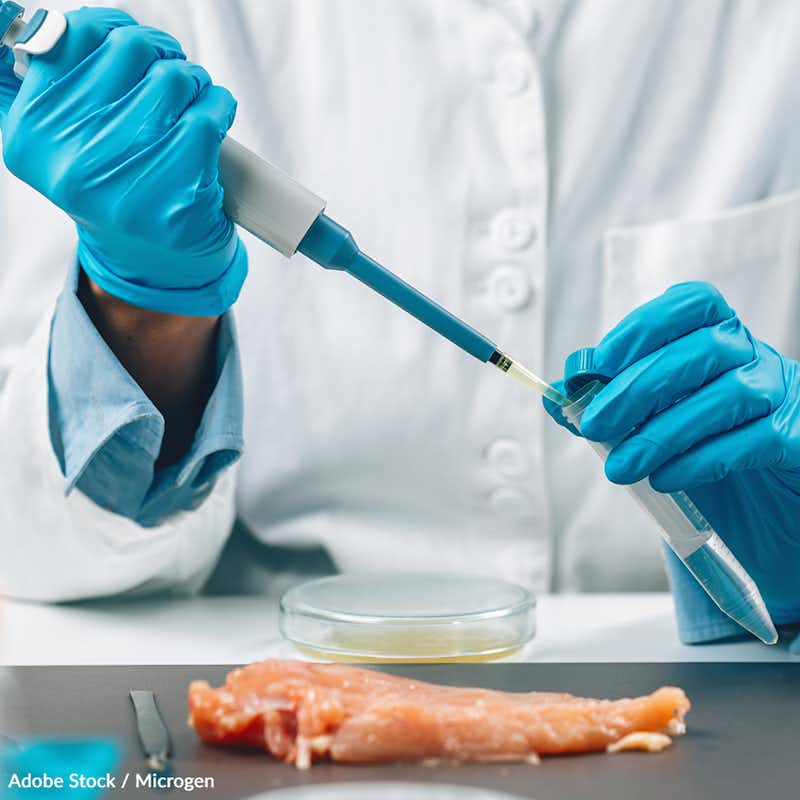Protect Americans Against Salmonella
10,359 signatures toward our 30,000 Goal
Sponsor: The Hunger Site

Salmonella is a foodborne bacteria that can travel on poultry and meat. In a number of cases, salmonella outbreaks have led to poisoning, lasting health issues, and even death1.
The Centers for Disease Control and Prevention estimates that Salmonella infection causes 23,000 hospitalizations and 450 deaths in the United States each year2.
Of those who are most vulnerable and most likely to get a Salmonella infection:
- Children under 5 years old.
- Infants (children younger than 12 months) who are not breast fed.
- Infants, adults aged 65 and older, and people with a weakened immune system.
- People taking certain medicines (for example, stomach acid reducers).
Raw poultry is the largest single source of salmonella infections, and salmonella causes more serious illnesses than any other foodborne pathogen3. It sickens about 1.35 millionpeople in the US each year; about 26,500 of them end up in the hospital, and 420 die2.
Mild cases of salmonella may result in fever and diarrhea, lasting up to a week3. But if the bacteria make their way to the bloodstream and infect bones, joints, and the nervous system, victims may eventually suffer from arthritis and long-term circulatory problems4.
Today, the USDA can only ask meat producers to voluntarily recall their products, and can force recalls only for contamination with E. coli O157:H7 or a few related strains that can severely damage red blood cells5. That power was not granted until 1993 when a salmonella outbreak outbreak at the Jack in the Box fast-food chain sickened 732 kids who ate hamburgers from the restaurant. Four of those children eventually died and left 178 with kidney and brain damage6.
Companies typically move at their own pace to remediate these risks. That leaves consumers vulnerable to threats they do not know exist.
More recently, a coalition of consumer groups have compelled a change in federal food-safety regulation that could close this gap in oversight7.
The US Department of Agriculture is now considering activating the power to monitor salmonella contamination in live birds and slaughterhouses, and to force producers to recall contaminated meat from the marketplace8.
The new framework calls for testing flocks as they arrive at slaughterhouses, which could motivate poultry growers to control the pathogen on their farms. It proposes further controls in slaughter and packaging, and maintains an “enforceable final product standard,” which would prohibit the release of products that contain dangerous strains of salmonella bacteria8.
The problem is, there are thousands of strains of salmonella, and not all of them cause serious illness9. This makes addressing contamination a complicated effort, requiring inspections of packaged meat as well as slaughterhouse and farm conditions.
It's work that must be done to prevent millions of Americans from getting sick every year from this dangerous bacteria.
Sign the petition and stop salmonella by supporting the FDA's proposed food safety framework!
- Centers for Disease Control and Prevention (31 July 2014), "Multistate Outbreak of Multidrug-Resistant Salmonella Heidelberg Infections Linked to Foster Farms Brand Chicken (Final Update)."
- Centers for Disease Control and Prevention (9 September 2022), "Questions and Answers."
- Healthline (17 Dept. 2018), "Will Eating Raw Chicken Make You Sick?."
- Mayo Clinic, "Salmonella infection."
- Benjamin Hibbert, MD, Cecilia Costiniuk, MD, Rebecca Hibbert, MD, Philip Joseph, MD, Haitham Alanazi, MD, Trevor Simard, BSc, Carole Dennie, MD, Jonathan B Angel, MD, and Edward R O’Brien, MD (Oct. 2010), "Cardiovascular complications of Salmonella enteritidis infection."
- Denis W. Stearns, The National Agricultural Law Center, "Preempting Food Safety: An Examination of USDA Rulemaking and Its E.coli 0157:h7 Policy in Light of Estate of Kriefall ex. rel. Kreifall v. Excell Corporation."
- Centers for Disease Control and Prevention, Morbidity and Mortality Weekly Report (16 April 1993), "Update: Multistate Outbreak of Escherichia coli O157:H7 Infections from Hamburgers -- Western United States, 1992-1993."
- Stop Foodborne Illness (14 October 2022), "Stop Foodborne Illness Reacts to USDA Announcement Regarding New Salmonella Framework."
- USDA Food Safety and Inspection Service (14 October 2022), "Proposed Regulatory Framework to Reduce Salmonella Illnesses Attributable to Poultry."
- USDA Food Safety and Inspection Service (14 October 2022), "USDA Releases Proposed Regulatory Framework to Reduce Salmonella Infections Linked to Poultry Products."
- Center for Science in the Public Interest, STOP Foodborne Illness, Consumer Federation of America, Consumer Reports, Mr. David Clubb, Ms. Amanda Craten, Ms. Diana Goodpasture, Ms. Mary Graba, Ms. Melissa Lee (25 January 2021), "Petition to Establish Enforceable Standards Targeting Salmonella Types of Greatest Public Health Concern while Reducing all Salmonella and Campylobacter in Poultry, and to Require Supply Chain Controls."
The Petition:
To the United States Secretary of Agriculture,
The Centers for Disease Control and Prevention estimates that Salmonella infection causes 23,000 hospitalizations and 450 deaths in the United States each year.
At highest risk are infants, young children, the elderly and those with weakened immune systems, which is a growing population in this era of global pandemic.
Today the USDA can only ask meat producers to voluntarily recall their products, and can only force related to contamination with E. coli O157:H7 or a few related strains that can severely damage red blood cells.
This does little to restrain salmonella outbreaks, but the "USDA's proposed food safety framework would change that story.
The new framework calls for testing flocks as they arrive at slaughterhouses, which could motivate poultry growers to control the pathogen on their farms. It proposes further controls in slaughter and packaging, and maintains an “enforceable final product standard,” which would prohibit the release of products that contain dangerous strains of salmonella bacteria.
I fully support this proposed food safety framework, and stand by your continued efforts to make this framework a law.
Sincerely,